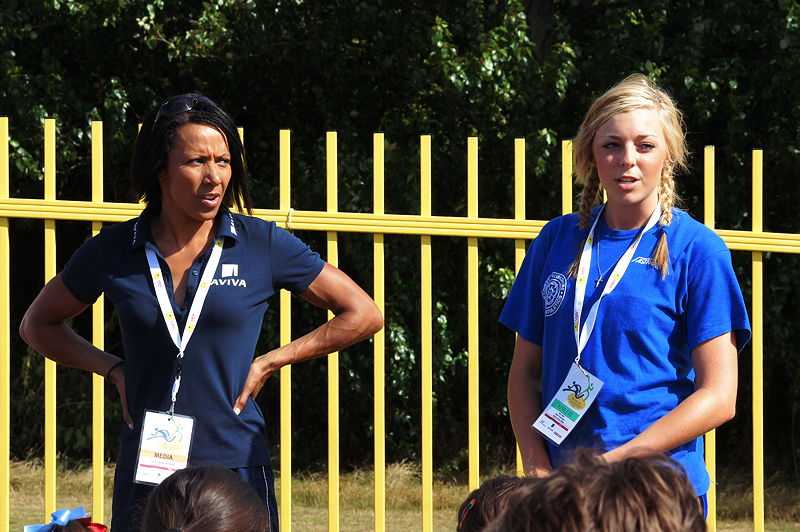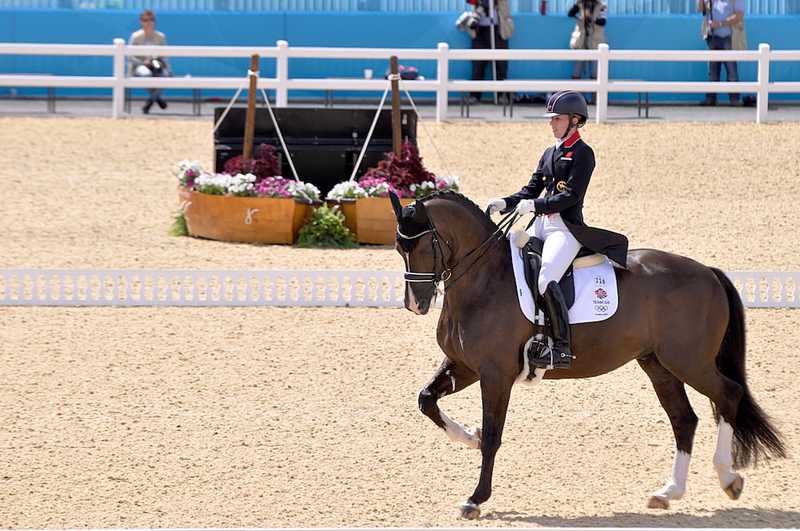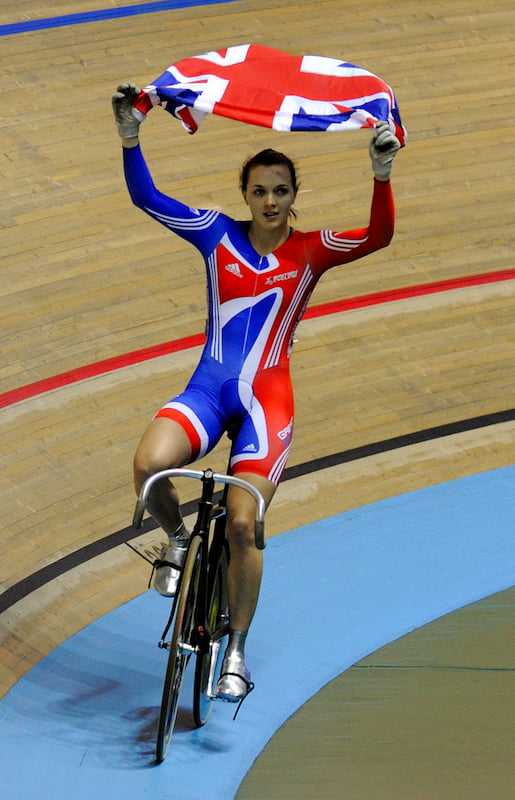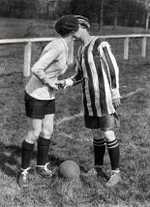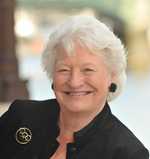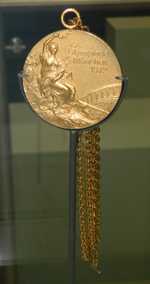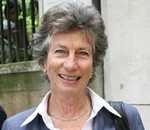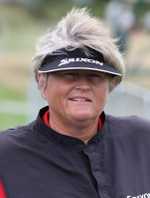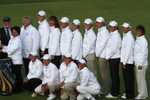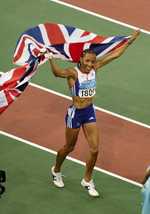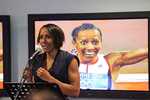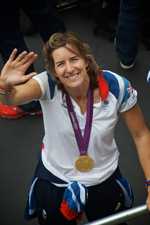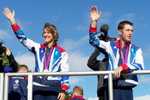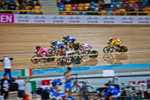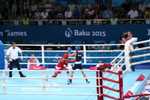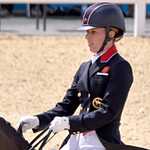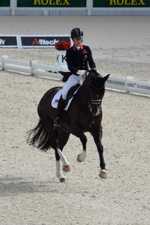1. Lilian Parr (1905-1978) – St. Helens – Football Player (Left Winger)
Parr was born to George, a labourer in a glass factory, and Sarah Parr.
She received a basic education, reading, writing, and arithmetic, and was expected to focus on learning to cook and sew.
Parr rejected that notion. Competing in both football and rugby with her brothers was her passion.
At age fourteen, Parr joined the St. Helens Ladies Football Team. She scored 108 goals her first year. After defeating The Dick, Kerr’s Ladies team, Alfred Frankland, Kerr’s manager, offered her a job with Dick, Kerr, and Company, a munitions plant in Preston, and a position on its ladies’ football team.
During Parr’s first season with Kerr’s team, she scored 43 goals. She was nearly six feet tall and strong. She was a “left-footer.” The strength and power of her kicking were hailed as her greatest assets, both in delivering from the left flank and shooting at goal.
In 1921, Parr’s team beat the Best of Britain 9-1. Parr scored five of those points. The French were touring England and Parr’s team beat them 5-1, with Parr scoring all five points.
During World War I (WWI), Parr’s team raised over 10 million pounds for the military. After WWI, the game of football was touted as unsuitable for females. The Football Association (FA) banned women from playing on their member grounds. Parr’s team toured the United States. They played nine games: won three, drew three, and lost three against the top division men’s teams.
In 1926 the team changed its name to The Preston Ladies. While playing football, Parr also trained as a nurse and worked in Whittingham Mental Hospital. After she retired, she continued to play women’s football, including a tour of France. Between 1919 and 1951, Parr totaled more than 900 goals.
Parr was not honored by Britain, per se, but she is the only woman to be made an inaugural inductee into the English Football Hall of Fame at the National Football Museum. She was the first female footballer commemorated with a statue and is the inspiration for a children’s book.
Parr died in 1978, but she lived to see the repeal of the FA’s ruling in 1971.
2. Mary Elizabeth Peters (1939-) Halewood – Pentathlon and Shotput
At age eleven, Peter’s family moved to Belfast. She was the only girl in her school that could beat the boys in the races.
She was invited to take part in pentathlon. Her status changed from “English Girl” to “Sporty Girl.”
At age sixteen, Peters trained in shot put and hurdle races and entered Northern Ireland championships. She broke the record in the shotput events.
While pursuing an athletic career, Peters also attended Portadown College and became a qualified teacher.
After a poor performance at the 1964 Summer Olympics in Tokyo and the 1968 Mexico Olympics, Peters decided to learn a new style of clearing high jump bars backwards, an innovation created by Dick Fosbury known as the “Fosbury Flop.” In the 1972 Summer Olympics, Peters beat West Germany’s Heidi Rosendahl. She won a Gold Medal and set a new world record in the 100 m hurdles. The event lasted two days and consisted of five events: hurdles, shot put, high jump, long jump, and a 200 m race.
Northern Ireland was in turmoil, but Peters was undeterred. “Gold or Nothing for Belfast” was Peters’ mantra. Between 1958 to 1974, she won two Gold Medals for the pentathlon and Gold and Silver medals for shotput.
A statue of Peters is on Northern Ireland’s Premier Athletics Track on the outskirts of Belfast.
3. Sarah Virginia Wade (1945-) Bournemouth – Tennis Player
Wade was the daughter of an archdeacon in Durban. She spent her formative years in South Africa where she learned to play tennis.
At age fifteen, the family moved back to England. She became a member of the tennis team of Wimbledon County Girls’ Grammar School.
She graduated from the University of Sussex in 1966, majoring in mathematics and physics.
In 1968, Wade turned professional and defeated Billie Jean King at the U.S. Open. In 1972, at the Australian Open, she beat Evonne Goolagong in the final 6-4, 6-4. In 1977, at Wimbledon, Wade beat Chris Evert 6-2, 4-6, 6-1 in the semi-final. In the final, she beat Betty Stone in three sets.
Later, she went on to win four major women’s doubles with Margaret Smith Court, two at the U.S. Open, one at the Australian Open, and one at the French Open.
After only 55 professional singles matches, Wade made it into the World's Top 10. She retained that ranking continuously from 1967–1979.
By 1986, Wade had retired from playing singles and doubles. She was the only British woman in history to have won titles at all four majors. She was ranked number two in the world in singles and number one in doubles.
Learn more on our Virginia Wade biography page.
4. Fatima Whitbread (1961-) Stoke Newington – Javelin Thrower
Whitbread was the daughter of a Greek Cypriot father and a Turkish Cypriot mother.
Abandoned by her mother at an early age, she was rescued by neighbours. Until her early teens, she lived in a series of welfare centres.
Whitbread attended Dilkes County Primary School and Culverhouse Secondary School. She had problems in school, but she enjoyed sports and was a regular at an athletic club near her home.
Her coach, Margaret Whitbread, nurtured her interest in sports. Later, Margaret and her husband adopted her. Fatima’s original surname changed from Verdad to Whitbread.
Whitbread’s first big success was in 1979 at the European Juniors in Bydgoszcz. She won a Gold Medal with a throw of 58.20 m, setting a national junior record. This was the first time a British woman had won the event.
In 1986, she represented England in the Stuttgart games. She broke the javelin world record with a throw of 77.44 m in the qualifying round and clinched the Gold Medal in the final.
Whitbread reached her pinnacle in 1987 when she defeated Petra Felke in the Second World Championships in Athletics in Rome and won the Gold Medal.
Whitbread is one of only two women in history to have thrown the javelin over 75 metres. She retired in 1989.
In 2012, Fatima adopted a child. She was fifty-seven, divorced, and had a grown son. She stated that she never forgot the kindness that had been given to her and she wanted to give back.
5. Laura Jane Davies (1963-) Coventry – Golfer
Davies spent her early childhood years in Surrey and in Marietta, GA (USA) where her father worked as an engineer with Lockheed Aircraft Corporation.
Her parents divorced when she was eight and she moved back to Surrey with her mother.
At age ten, Davies’ father taught her how to play golf. During school holidays Sundown Golf Centre in Surrey served as “babysitter.” Her mother left her and her brother there all day until she returned from work. Davies perfected her skill on a nine-hole par-three course all day.
Turning professional in 1985, Davies became a part of the Ladies European Tour. In 1986, she won the Ladies British Open at Birkdale and in 1987, she won the U. S. Women’s Open at Plainfield Country Club, New Jersey (USA).
In 1988, she won twice as a rookie on the LPGA Tour, three times on the Ladies European Tour, and once in Japan. Initiating a record of “firsts”, Davies was the first woman to win on all three major tours in the same year.
In 1990, she was the all-time leader in points won in the Solheim Cup. She was the only player to participate in the first twelve Solheim Cup matches (1990-2011) on the U.S. or European side.
Davies was the first in 1994 to win on five different golf tours in one calendar year: U.S., Europe, Asia, Japan, and Australia, including the Du Maurier Classic in Canada in 1994 and 1996.
Davies was the first player to win the same tournament four times at the J Golf Phoenix LPGA International in four consecutive years.
In 2015, Davies was inducted into the World Golf Hall of Fame.
6. Kelly Holmes (1970-) Pembury – Middle Distance Runner
Holmes was born to Derrick Holmes, a car mechanic, and Pam Norman. When she was seven, her mother married painter and decorator Michael Norris.
Holmes attended Hildenborough CEP School and Hugh Christie Comprehensive School in Tonbridge. In 1982, she joined the Tonbridge Athletic Club. In 1983, she won the English Schools 1500 metres.
At age eighteen, Holmes joined the Women’s Royal Army Corps (WRAC). She became a Heavy Goods Vehicle (HGV) driver.
After becoming a British army judo champion, Holmes competed and won an 800 m, a 3,000 m, and a relay race in a single day. She also won the heptathlon.
In 1997, Holmes became a full-time athlete while working in the military. In 2003, she injured her leg during training. She became “clinically depressed.” By 2004, she had recovered and was able to compete in the Olympics. She won a Gold Medal and became the seventh British woman to win an athletic gold.
She also became the third woman to do the 800 m and 1500 m double, becoming Britain’s first double gold medalist at the same games. Her time of 3 minutes 57.90 seconds in the 1500 m final set was a new British record for the distance.
Holmes retired in 2005. In 2008, she founded the Dame Kelly Holmes Trust to support young athletes.
7. Katherine Jane Grainger (1975-) Glasgow – Rower
In 1993, while working at the University of Edinburgh on a Bachelor of Laws degree, Grainger took up rowing and represented Edinburgh’s St. Andrew Boat Club and Marlow Rowing Club.
Between 1997 and 2011, Grainger won a Bronze, three Silver, and four Gold Medals in quadruple sculls, double sculls, and coxless pairs.
During this period, Grainger continued her education, earning a Master of Philosophy in Medical Law and Medical Ethics from the University of Glasgow, and a Doctor of Philosophy in law from King’s College London.
In 2012, at the London Olympics, Grainger and Anna Watkins broke the Olympic record as they qualified for the double sculls final and won the Gold Medal. Grainger is regarded as Great Britain’s most decorated female Olympian.
8. Victoria Louise Pendleton (1980-) Stotfold – Track Cyclist
Pendleton and her twin brother were born to Max Pendleton, a cyclist and former British national 8 km grass track cycling champion, and Pauline M. Viney.
Pendleton was educated at Northumbria University in Newcastle upon Tyne, earning a degree in Sport and Exercise Science.
In 2005, Pendleton won her first Gold Medal in the sprint at the 2005 UCI Track Cycling World Championships. She became the third British woman to become a cycling world champion in forty years.
In 2006, at the Commonwealth Games in Melbourne, Pendleton won Gold in the sprint.
In 2007, at the UCI Track Cycling World Championships, Pendleton won the team sprint with Shanaze Reade, the individual Gold in the sprint, and a third Gold in the Keirin.
Pendleton was named the Sunday Times Sportswoman of the Year for 2007, becoming the first cyclist to win the award in its 20-year history.
In 2008, Pendleton won two Gold Medals at the UCI Track Cycling World Championships in the sprint and team sprint with Reade, followed by a Gold Medal in the sprint in the Summer Olympics, and a win in the UCI Track.
In 2012, Pendleton and Jess Varnish set a new world team sprint record of 32.754 seconds beating Kaarle McCulloch and Anna Meares of Australia at the Track World Cup in the London Velodrome.
A Gold Medalist at the European, World, and Olympic levels, Pendleton was inducted into the European Cycling Union Hall of Fame.
9. Nicola Adams (1982) Leeds – Boxer (Flyweight)
Adams was born to Innocent and Denver Adams. She was educated at Hopwood Hall College in Rochdale.
In 2010, Adams was chosen to be part of Great Britain’s Female Boxing Squad. She was one of seven women. She was placed in the flyweight division and began a steady stream of Gold Medals in the Olympics and European Championships.
In 2011, she fought at the European Union Amateur Boxing Championship in Katowice and earned a Gold Medal. She also won a Gold Medal at the Olympic Games in London in 2012, becoming the first woman in history to win a Gold Medal in boxing. She repeated this feat in 2014 in the Commonwealth Games in Glasgow, and in Rio in 2016.
In 2017, Adams turned professional and won a four-round victory at the Manchester Arena.
In 2018, at the Morningside Arena in Leicester, Adams won a ten-round bout. Scheduled to fight the next year at the Royal Albert Hall in London, she was injured during training and had to cancel the fight. Ironically, her opponent, Arely Mucino, while defending her title, suffered an injury and later was involved in a car crash.
This elevated Adams to full World Boxing Organization (WBO) championship. In 2019, she successfully defended her title with Maria Salinas, but suffered an injury to her eye.
Upon her doctor’s advice, she retired after the fight rather than risk permanent eye damage.
Adams had an undefeated record of six major fights: five wins (3 KO’s), and one draw.
10. Charlotte Susan Jane Dujardin (1985-) Enfield – Dressage Equestrian
Dujardin left school at sixteen to pursue riding.
In 2007, Carl Hester asked Dujardin to develop Valegro, a Dutch Warmblood Gelding.
In 2011 Dujardin won a Gold Medal in a European Dressage championship in Rotterdam. In that same year, she won the FEI World Cup Grand Prix at London Olympia, setting a new world record for the Olympic Grand Prix special discipline by point-scoring at 88.022%.
In 2012, Dujardin represented Great Britain in the Summer Olympics. She won the Gold Medal and set a record of 83.784%. Two days later, she won another Gold Medal with a score of 90.089%.
In 2016, at the Rio Olympics, Dujardin won an individual Gold Medal. She was the first British woman to retain an individual Olympic title and set a new Olympic dressage score of 93.857 in the Grand Prix Freestyle. In the same year, at the Summer Olympics, she won the Gold Medal for the Dressage section of Equestrian.
Dujardin was the most successful British Olympic equestrian and dressage rider in the history of the sport and the winner of all major titles and world records.
11. Conclusion
British female athletes proved they had athletic prowess.
In appreciation for their efforts, they were honoured with one or more of Britain’s coveted awards:
- Dame Commander of the British Empire (DBE – Peters, Davies, Grainger, Holmes)
- Commander of the Order of the British Empire (CBE – Peters, Pendleton, Dujardin)
- Officer of the Most Excellent Order of the British Empire (OBE - Peters, Wade, Adams)
- Member of the Order of the British Empire (MBE – Peters, Whitbread, Adams)
